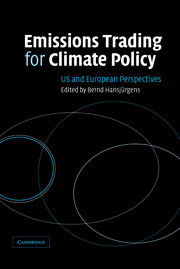Book contents
- Frontmatter
- Contents
- List of figures
- List of tables
- List of contributors
- Preface
- List of abbreviations
- 1 Introduction
- Part 1 Regulatory instruments for climate policy: theoretical aspects
- 2 Designing instruments for climate policy
- 3 Technical innovation and design choices for emissions trading and other climate policies
- 4 Incentives to adopt new abatement technology and US–European regulatory cultures
- Part 2 The US approach to pollution control: lessons for climate policy
- Part 3 European policies to control greenhouse gases: the EU directive on emissions trading
- 14 Concluding observations
- Index
- References
3 - Technical innovation and design choices for emissions trading and other climate policies
Published online by Cambridge University Press: 22 September 2009
- Frontmatter
- Contents
- List of figures
- List of tables
- List of contributors
- Preface
- List of abbreviations
- 1 Introduction
- Part 1 Regulatory instruments for climate policy: theoretical aspects
- 2 Designing instruments for climate policy
- 3 Technical innovation and design choices for emissions trading and other climate policies
- 4 Incentives to adopt new abatement technology and US–European regulatory cultures
- Part 2 The US approach to pollution control: lessons for climate policy
- Part 3 European policies to control greenhouse gases: the EU directive on emissions trading
- 14 Concluding observations
- Index
- References
Summary
Introduction
Climate change is a serious public policy issue because it may impose costs on society, including adverse human health impacts, productivity losses, and degradation of valued natural resources. On the other hand, policies to reduce greenhouse gases can have serious economic consequences, such as higher costs of production and increased energy expenses for households. This trade-off is the classic problem for policy-makers trying to strike a balance between the costs and benefits of environmental regulation.
The political balancing act would become much easier if policy could generate a “win–win” scenario with both environmental and economic benefits. Thus, much attention has been given to the “Porter hypothesis” that environmental regulation can actually increase the profits of firms, chiefly by encouraging them to look for more efficient production technologies that ultimately lower their costs (Porter and van der Linde, 1995). Economists traditionally doubt the concept of a free lunch: if such gains in efficiency were worthwhile in the first place, why would firms not take advantage of them without regulation? What appears to be cost savings due to regulation can often be negated by proper accounting of management time and other human resource costs, for example (Palmer et al., 1995).
Some theories have been developed to explain how “win–win” situations might arise (Sinclair-Desgagné, 1999).
- Type
- Chapter
- Information
- Emissions Trading for Climate PolicyUS and European Perspectives, pp. 37 - 52Publisher: Cambridge University PressPrint publication year: 2005
References
- 7
- Cited by



